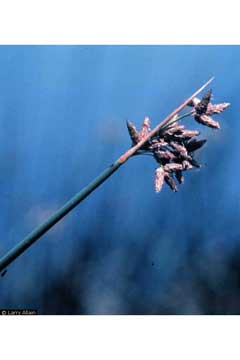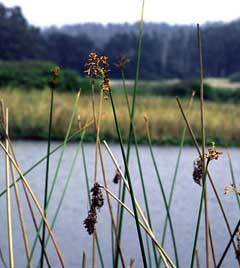 |
|
Larry Allain @ USDA-NRCS PLANTS Database |
 |
| www.fws.gov |
Translate this page:
Summary
Physical Characteristics

 Scirpus acutus is a PERENNIAL growing to 2 m (6ft 7in) at a fast rate.The seeds ripen from July to August. The species is hermaphrodite (has both male and female organs) and is pollinated by Wind.
Scirpus acutus is a PERENNIAL growing to 2 m (6ft 7in) at a fast rate.The seeds ripen from July to August. The species is hermaphrodite (has both male and female organs) and is pollinated by Wind.
Suitable for: light (sandy), medium (loamy) and heavy (clay) soils. Suitable pH: mildly acid, neutral and basic (mildly alkaline) soils. It can grow in semi-shade (light woodland) or no shade. It prefers moist or wet soil and can grow in water.
UK Hardiness Map
US Hardiness Map
Synonyms
S. occidentalis.
Plant Habitats
Pond; Bog Garden;
Edible Uses
Edible Parts: Leaves Pollen Root Seed Shoots
Edible Uses:
Root - raw or cooked[62, 161]. Rich in starch, it has been ground into a powder and used with cereal flours in making bread[212]. The roots can be boiled with water and made into a syrup[257]. The roots are usually peeled before being eaten[257]. Pollen[62]. Rich in protein, it can be added to flour when making bread, cakes etc. Seed[62, 257]. Small and fiddly to utilize. White stem bases and tender young shoots - raw or cooked[257]. Harvested in the spring[161], they are crisp and sweet[212]. New shoots form in the autumn and make a welcome snack[212]. The inner portions of the stems can be eaten raw[257].
References More on Edible Uses
Medicinal Uses
Plants For A Future can not take any responsibility for any adverse effects from the use of plants. Always seek advice from a professional before using a plant medicinally.
Haemostatic
The stem pith is haemostatic[257]. A poultice of the pith is placed under a dressing in order to stop the wound bleeding[257]. The roots have been chewed as a preventative to thirst[257].
References More on Medicinal Uses
The Bookshop: Edible Plant Books
Our Latest books on Perennial Plants For Food Forests and Permaculture Gardens in paperback or digital formats.

Edible Tropical Plants
Food Forest Plants for Hotter Conditions: 250+ Plants For Tropical Food Forests & Permaculture Gardens.
More

Edible Temperate Plants
Plants for Your Food Forest: 500 Plants for Temperate Food Forests & Permaculture Gardens.
More

More Books
PFAF have eight books available in paperback and digital formats. Browse the shop for more information.
Shop Now
Other Uses
Basketry Paper Weaving
A fibre obtained from the stems is used for making paper[189]. The fresh stems can be harvested in summer, or dried stems can be used at any time of the year. The stems are split and cut into usable pieces, soaked for 24 hours in clear water and then cooked for 1½ hours with lye. The fibres are then beaten in a blender and can be used to make a beige/brown paper[189]. The stems and leaves are used for weaving or sewing together into hats, mats, mattresses etc[61, 189, 257]. The stems are very durable and take a year or more to decay in the wild[212]. The stems have been used in basket making[257]. The outer surface of the stems has been split and twisted into weft cords and warp[257].
Special Uses
References More on Other Uses
Cultivation details
We have very little information on this species and do not know if it will be hardy in Britain, though judging by its native range it should succeed outdoors in most parts of this country. The following notes are based on the general needs of the genus. Succeeds in any wet to moisture retentive ground, pond margins and shallow water in full sun or shade[200].
References Carbon Farming Information and Carbon Sequestration Information
Temperature Converter
Type a value in the Celsius field to convert the value to Fahrenheit:
Fahrenheit:
The PFAF Bookshop
Plants For A Future have a number of books available in paperback and digital form. Book titles include Edible Plants, Edible Perennials, Edible Trees,Edible Shrubs, Woodland Gardening, and Temperate Food Forest Plants. Our new book is Food Forest Plants For Hotter Conditions (Tropical and Sub-Tropical).
Shop Now
Plant Propagation
Seed - sow in a cold frame as soon as it is ripe in a pot standing in 3cm of water. Only just cover the seed with soil[200]. The seed usually germinates fairly quickly. Prick out the plants when large enough to handle and plant out in their permanent positions in early summer. Division in spring. Very easy, larger divisions can be planted out direct into their permanent positions. We have found it best to pot up the smaller divisions and grow them on in a lightly shaded position in a cold frame, planting them out once they are well established in the summer.
Other Names
If available other names are mentioned here
Native Range
NORTHERN AMERICA: Canada (Northwest Territories, Yukon, Québec, Nova Scotia, Ontario, Prince Edward Island, New Brunswick, Saskatchewan, Alberta, Manitoba, British Columbia), United States (Alaska (south), Indiana, Maine, Massachusetts, Michigan, New Hampshire, New Jersey, New York, Ohio, Pennsylvania, Rhode Island, Vermont, Connecticut, Illinois, Iowa, Kansas, Minnesota, Missouri, Nebraska, North Dakota, Oklahoma, South Dakota, Wisconsin, Colorado, Idaho, Montana, Oregon, Washington, Wyoming, Arkansas, Delaware, Kentucky, Maryland, North Carolina, Virginia, New Mexico, Texas, Arizona, California, Nevada, Utah), Mexico (Baja, Chihuahua, Coahuila de Zaragoza)
Weed Potential
Right plant wrong place. We are currently updating this section.
Please note that a plant may be invasive in one area but may not in your area so it's worth checking.
Conservation Status
IUCN Red List of Threatened Plants Status :

Growth: S = slow M = medium F = fast. Soil: L = light (sandy) M = medium H = heavy (clay). pH: A = acid N = neutral B = basic (alkaline). Shade: F = full shade S = semi-shade N = no shade. Moisture: D = dry M = Moist We = wet Wa = water.
Now available:
Food Forest Plants for Mediterranean Conditions
350+ Perennial Plants For Mediterranean and Drier Food Forests and Permaculture Gardens.
[Paperback and eBook]
This is the third in Plants For A Future's series of plant guides for food forests tailored to
specific climate zones. Following volumes on temperate and tropical ecosystems, this book focuses
on species suited to Mediterranean conditions—regions with hot, dry summers and cool, wet winters,
often facing the added challenge of climate change.
Read More
Expert comment
Author
Muehl. ex Bigelow.
Botanical References
43274
Links / References
For a list of references used on this page please go here
Readers comment
| Add a comment |
|
If you have important information about this plant that may help other users please add a comment or link below. Only comments or links that are felt to be directly relevant to a plant will be included. If you think a comment/link or information contained on this page is inaccurate or misleading we would welcome your feedback at [email protected]. If you have questions about a plant please use the Forum on this website as we do not have the resources to answer questions ourselves.
* Please note: the comments by website users are not necessarily those held by PFAF and may give misleading or inaccurate information.
To leave a comment please Register or login here All comments need to be approved so will not appear immediately.
|
|